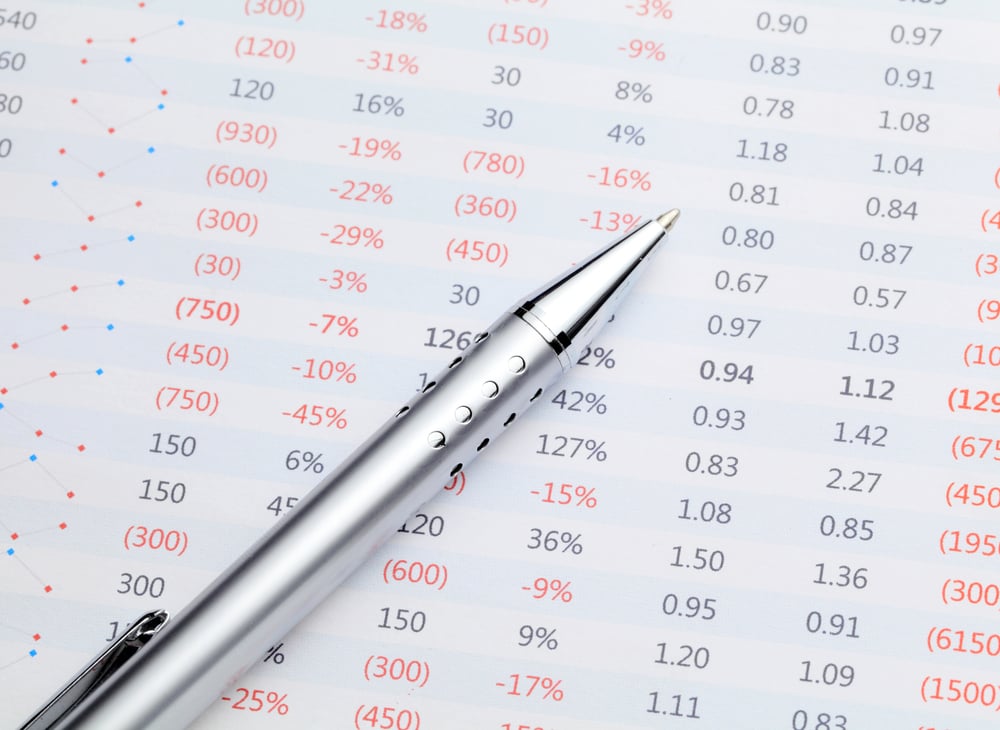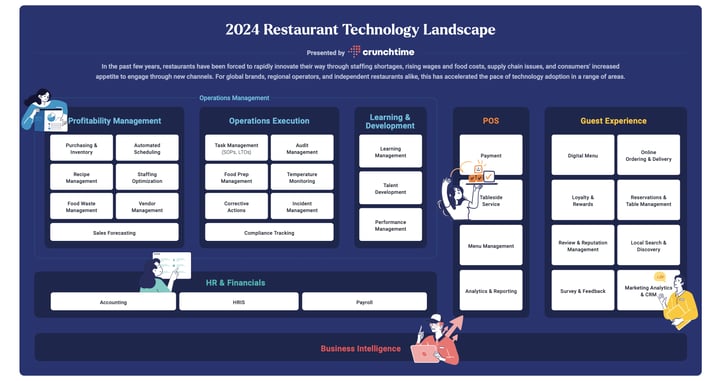
- Home
- Crunchtime Blog
- 5 Ways to Leverage Restaurant Data Analytics for Business Growth

5 Ways to Leverage Restaurant Data Analytics for Business Growth
Helping restaurants grow and thrive, effective restaurant data analytics can improve customer retention levels, brand awareness strategy, and brand image too. But what exactly are they, and how can you take advantage of them to help your restaurant grow? Let’s take a closer look.
How are analytics used in the restaurant industry?
As one of the most competitive industries around, savvy restaurant businesses are reaping valuable insights from data analytics to drive revenue, growth, and efficiency. Typical analytics that restaurants actively monitor to improve operations include:
- Busiest times and days: Ensure you have enough staff, ingredients, and seating to cover your busiest times. Used to identify quiet times to initiate important training and team-building sessions, you can also leverage peak times to offer additional revenue-generating offers and discounts.
- Best-performing locations: For restaurants with multiple locations, metrics like average transaction size help to identify the best-performing premises and provide support to those trailing behind.
- Digital sales channel performance: If you use an online food delivery company (Uber Eats, Grubhub, etc.), you can identify the most lucrative channel, which, in turn, helps to perfect your menus and inspire future promotional offers.
- Ingredient price changes: An instant overview of your ingredients saves valuable time and energy looking for them and helps you stay ahead of vendor price changes.
- Identification of rogue spending: Rogue spending is when ingredients, equipment, and other essential items are purchased outside the standard documented purchasing process. Accounting for up to 80% of a restaurant's total spend in some cases, being able to identify rogue (or maverick) buying offers substantial money-saving potential.
- Historical sales trends: Access to location-specific sales insights makes future budgeting decisions and predicting future sales trends that much easier.
- Best-performing review sites: Gathering reviews from review sites like Google, Yelp, and Tripadvisor helps restaurants compare customer feedback from different platforms and identify key trends and improvements.
Free to use image sourced from Pexels
How can data increase restaurant business revenue?
Data analytics tools for restaurants can also help leverage crucial customer and operational data further. We’ll cover this later on. Here we've listed the top three ways to leverage your restaurant data to increase profits and trigger business growth.
1. Inventory Analytics
Tracking inventory and stock numbers prevents every restaurant owner's worst nightmare; running out of ingredients mid-service. Shockingly, around 40% of the food served to customers is never eaten. So, to help the environment, reduce waste and unnecessary expenditure, inventory tracking helps keep a close eye on food waste too.
Free to use image sourced from Pexels
Good inventory management is at the heart of all profitable restaurant businesses. By automating inventory analytics, the chance of error is considerably reduced. Used to streamline invoice uploading, evidence stock counts, and automatically update item prices in line with accounting data, proper food and inventory management equals more satisfied customers and better interactions with vendors, too.
2. Menu analytics
Menu analytics, like most ordered menu items help to gauge menu profitability and work out which option is driving repeat custom to you. Understand what's working and what isn't to streamline your menu and lessen expenditure even further.
Knowing your customers’ menu preferences, purchase history, favored payment methods, and more is really worth its weight in gold. Whether it's offering bespoke promotions or free items, creating a personalized experience for repeat customers provides an ideal way to build that all-important customer loyalty.
Additionally, analyzing the data from your restaurant menu can help you identify which dishes are the most popular and profitable, allowing you to optimize your menu offerings for increased revenue and customer satisfaction.
3. Employee analytics
As well as key customer data, restaurant analytics can also be used to monitor staff performance. From the highest sales transactions to employee turnover rate, the future of managing employee performance and successful business growth lies in the data. By revealing your staff's strengths and weaknesses, you can create strategies to reduce low performance and improve sales.
Even better, restaurant data analytics can be used to uncover new ways to decrease staff turnover and increase employee happiness levels, too. After all, a committed and motivated team is key to scaling up a restaurant business.
How can data be used to improve restaurant sales and performance?
1. Recognize data streams
Correct data extraction and handling holds the key to boosting restaurant business growth. Other important data sources for restaurants to analyze include:
- Reservation system
- Customer ratings and feedback
- Social media analytics
- Customer demographics
- Local conditions
- Market trends
Free to use image sourced from Pexels
2. Track website analytics
If you have a website or an online ordering portal, restaurant owners can take full advantage of Google Analytics. Valuable insights you can gather and evaluate with Google Analytics include:
- Visitor traffic by city
- Traffic by the time of day
- Traffic by device (desktop, tablet, and mobile)
- Device traffic competitor comparisons
- Page loading speeds
Tracking website visitors provides valuable insight into who's viewing your restaurant online, the most popular pages they visit, and how they find them.
3. Manage customer relationships
Imagine if there was a way to keep every single customer visit on file, including their orders and preferences. Modern restaurants that prioritize high-quality communication for making reservations and managing customers' feedback often also invest in cloud contact center platform technology to supercharge their customer experience.
Even better, cloud contact centers can be used to collect, measure, and report on key restaurant performance metrics, too, such as:
- Key data. Knowing your customer is a vegetarian, for example, can help tailor future marketing communications. If you like the idea of integrating real-time communication into your existing restaurant applications, Communications Platform as a Service (CPaaS) allows you to add embedded communications channels to your restaurant apps. A classic example of CPaas technology use within the restaurant industry is streamlined delivery updates for online orders. Boosting brand identity and increasing scalability, there are many benefits of CPaaS for proactive restaurant owners who value communication.
Free to use image sourced from Pexels
- Marketing campaigns. Leveraging a marketing data platform that helps marketing teams automatically connect data from email, text messages, and social media can allow them to visualize and share key information seamlessly from one centralized source.
- Reporting. Most CRMs allow you to track the success of your marketing campaign, offering insight into open rates and click-through rates for emails.
- Integrations. Restaurant data analytics are there to make your life easier. So, you should also consider how easily the restaurant CRM software integrates with other systems already in place. From reservation booking systems to loyalty schemes and guest feedback schemes, smooth restaurant CRM integration with email and other tools helps you get the most out of your restaurant data with the least amount of hassle involved. To enhance security and privacy one step further, you could employ a data engineer to design your own data engineering platform. Primarily helping restaurants make better decisions, improve the user experience, and identify new opportunities, as restaurant data continues to grow, the importance of data engineering within the restaurant industry is constantly increasing.
4. Build a targeted marketing campaign
Now you've gathered and analyzed your restaurant data analytics, it's time to grab your customers' attention with some targeted advertising.
Personalized marketing based on customer data can create a memorable and more engaging experience. This is why social media marketing, SEO, and email marketing often feature in successful restaurant marketing strategies.
5. Find more opportunities for growth
Helping make better decisions all around, when handled correctly, your unique restaurant data can reveal hidden business opportunities, too. High-quality data collection is the key to success here.
To identify more growth opportunities, essential factors to think about include:
- Consumer segmentation
- Purchase situation analysis
- Direct competitor analysis
- Indirect competitor analysis
- Complementary product and service analysis
- Diversification analysis
- Environmental analysis
The Bottom Line
With restaurant profit margins and competition for customers showing no signs of slowing, tracking crucial analytics through system integrations and other digital sources has never been easier.
Changing the restaurant industry for the better, restaurant managers and owners that adopt intuitive data analytics processes now will help to prepare for tomorrow's customers today.
To learn more about operational intelligence, click here.
Share this post
Related


The Restaurant Technology Ecosystem
-1.jpeg?length=720&name=AdobeStock_260525795%20(1)-1.jpeg)

